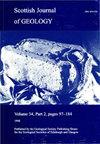苏格兰斯凯岛下侏罗纪“腔体级”兽脚亚目标本的修订
IF 1.3
4区 地球科学
Q4 GEOLOGY
引用次数: 0
摘要
早期掠食性恐龙最广泛的多样性是“腔骨类”新足类,但它们的hettangan - sinemurian(约191-201 Ma)记录在世界范围内是罕见的。在三叠纪末大灭绝(c. 201 Ma)之后,需要更多的信息来阐明这一恐龙群的进化。在这里,我们重新审视了这些最早的侏罗纪新足类标本之一的解剖和系统发育,这是一块来自苏格兰斯凯岛下Sinemurian的分离的部分胫骨,之前被认为可能与Liliensternus liliensterni和腔体类密切相关。然而,我们发现Skye标本与来自英格兰中部Hettangian-lower Sinemurian的woodsarcosaurus和一个由速盗龙和Averostra组成的分支(角鼻龙+破伤风科)位于一个分支中。Skye标本的形态与参考标本一致,但由于它可能代表一个骨骼未成熟的标本,我们将其定为cf. Sarcosaurus woodi。Skye标本增加了在欧洲下侏罗纪记录到的averostranline新足类标本的数量,目前的证据表明,这些形式,而不是腔骨类,在当时的世界这一地区相对常见。补充资料:用于系统发育分析的特征列表和数据集以及胫骨的3D模型可在https://doi.org/10.6084/m9.figshare.c.6863016上获得。主题集合:本文是苏格兰古生物学集合的一部分,可在https://www.lyellcollection.org/topic/collections/palaeontology-of-scotland上获得本文章由计算机程序翻译,如有差异,请以英文原文为准。
A revision of the ‘coelophysoid-grade’ theropod specimen from the Lower Jurassic of the Isle of Skye (Scotland)
The broadest diversification of early predatory dinosaurs is represented by the ‘coelophysoid-grade’ neotheropods, but their Hettangian–Sinemurian ( c. 191–201 Ma) record is scarce worldwide. More information is needed to shed light on the evolution of this dinosaur group after the end-Triassic mass extinction ( c. 201 Ma). Here we revisit the anatomy and phylogeny of one of these earliest Jurassic neotheropod specimens, an isolated partial tibia from the lower Sinemurian of the Isle of Skye (Scotland) that was previously identified as probably closely related to Liliensternus liliensterni and coelophysids. However, we found that the Skye specimen is positioned in the branch leading to Averostra (Ceratosauria + Tetanurae), in a polytomy with Sarcosaurus woodi from the late Hettangian–lower Sinemurian of central England and a clade composed of Tachiraptor admirabilis and Averostra. The morphology of the Skye specimen is congruent with that of referred specimens of Sarcosaurus woodi , but because it probably represents a skeletally immature specimen, we assign it to cf. Sarcosaurus woodi . The Skye specimen increases the number of averostran-line neotheropod specimens recorded in the Lower Jurassic of Europe and current evidence indicates that these forms, and not coelophysoids, were relatively common in this part of the world at that time. Supplementary material : Character list and dataset for phylogenetic analysis and 3D model of the tibia are available at https://doi.org/10.6084/m9.figshare.c.6863016 Thematic collection: This article is part of the Palaeontology of Scotland collection available at: https://www.lyellcollection.org/topic/collections/palaeontology-of-scotland
求助全文
通过发布文献求助,成功后即可免费获取论文全文。
去求助
来源期刊

Scottish Journal of Geology
地学-地质学
CiteScore
1.70
自引率
0.00%
发文量
10
审稿时长
>12 weeks
期刊介绍:
Although published only since 1965, the Scottish Journal of Geology has a long pedigree. It is the joint publication of the Geological Society of Glasgow and the Edinburgh Geological Society, which prior to 1965 published separate Transactions: from 1860 in the case of Glasgow and 1863 for Edinburgh.
Traditionally, the Journal has acted as the focus for papers on all aspects of Scottish geology and its contiguous areas, including the surrounding seas. The publication policy has always been outward looking, with the Editors encouraging review papers and papers on broader aspects of the Earth sciences that cannot be discussed solely in terms of Scottish geology.
The diverse geology of Scotland continues to provide an important natural laboratory for the study of earth sciences; many seminal studies in geology have been carried out on Scottish rocks, and over the years the results of much of this work had been published in the Journal and its predecessors.
The Journal fully deserves its high reputation worldwide and intends to maintain its status in the front rank of publications in the Earth sciences.
 求助内容:
求助内容: 应助结果提醒方式:
应助结果提醒方式:


